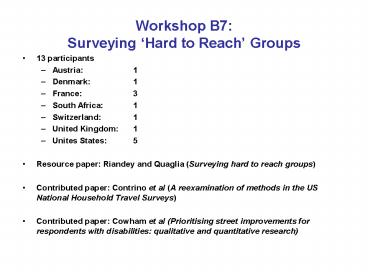Workshop B7: Surveying - PowerPoint PPT Presentation
1 / 10
Title:
Workshop B7: Surveying
Description:
Who are hard to reach' groups in travel surveys, and how does this differ by ... Illegal immigrants. Transients. Squatters. Homeless. Sub-letters. Group quarters ... – PowerPoint PPT presentation
Number of Views:26
Avg rating:3.0/5.0
Title: Workshop B7: Surveying
1
Workshop B7Surveying Hard to Reach Groups
- 13 participants
- Austria 1
- Denmark 1
- France 3
- South Africa 1
- Switzerland 1
- United Kingdom 1
- Unites States 5
- Resource paper Riandey and Quaglia (Surveying
hard to reach groups) - Contributed paper Contrino et al (A
reexamination of methods in the US National
Household Travel Surveys) - Contributed paper Cowham et al (Prioritising
street improvements for respondents with
disabilities qualitative and quantitative
research)
2
Questions discussed
- Who are hard to reach groups in travel surveys,
and how does this differ by type of survey (e.g.
telephonic vs. mail-back vs. home interview,
etc.) and by context? - What bias is introduced by lack of coverage of
hard-to-reach groups? E.g. how does their
absence/under-representation affect our estimates
and forecasts of travel, or public policies? - Looking forward, how do we foresee this
problemgetting less, getting worse? Why? - What measures can be taken to ensure that hard
to reach groups are included adequately in
sample frames and selections? - What measures can be taken to ensure that
selected hard to reach respondents are
successfully recruited and surveyed? - What forms of survey instruments are appropriate
to reach hard to reach groups, and how should
these instruments be developed and tested? - If we could completely re-design survey practice,
what kinds of things would we include to
integrate respondents from hard-to-reach groups
into the survey?
3
1. Who are hard to reach groups in travel
surveys, and how does this differ by type of
survey (e.g. telephonic vs. mail-back vs. home
interview, etc.) and by context?
- Persistent non-responders
- Foreign language
- Illiterates
- Disengaged
- High/low income
- Adolescents
- Fearful
- Gate-kept individuals
- Physically disabled
- Mentally disabled
- Non-coverage in sample frames
- Illegal immigrants
- Transients
- Squatters
- Homeless
- Sub-letters
- Group quarters
- Inaccessible workers
4
2. What bias is introduced by lack of coverage of
hard-to-reach groups? E.g. how does their
absence/under-representation affect our estimates
and forecasts of travel, or public policies?
- Bias depends on
- Survey method (e.g. CATI vs. PAPI vs. CASI vs.
CAWI) - Context
- Significance varies by survey purpose
- Aggregate travel patterns
- Special group surveys
- Research gap size of HTR groups
5
3. Looking forward, how do we foresee this
problemgetting less, getting worse? Why?
- Drivers of change
- Technology
- Migration
- Demography
- Economy
- Legal barriers/benefits
6
4. What measures can be taken to ensure that
hard to reach groups are included adequately in
sample frames and selections?
- Multi-frame sampling
- Land line phone
- Mobile phone
- Address frame
- Association/organization membership lists
- Etc.
- Identification and recruiting
- General population surveys frame completeness
- Specific population surveys cost of screening
to identify individuals, or access panels
7
5. What measures can be taken to ensure that
selected hard to reach respondents are
successfully recruited and surveyed?
- Toolkit of recruitment techniques
- Advertisements
- Association registers/lists
- Advance letters
- Endorsements
- Incentives/gifts
- Language specialists
8
6. What forms of survey instruments are
appropriate to reach hard to reach groups, and
how should these instruments be developed and
tested?
- Multi-modal with special components tailored for
HTRGs - But are results compatible with main survey?
- Non-response follow up surveys of two types
- Short last-ditch version to get essential
travel-related information - Short questionnaire for demographics/reasons for
non-response - Mode depends on HTRG
- Dont wait until end
- Design of instrument depends on purpose
9
7. If we could completely re-design survey
practice, what kinds of things would we include
to integrate respondents from hard-to-reach
groups into the survey?
- Ideal device to encourage HTRGs to participate
- Inexpensive
- Attractive/useful as a give-away after data
collection finished - Customizable for HTG group
- Non-intrusive
- Secure
- Passive fully automated data collection
- Multiple sensing capabilities not just GPS
- Close to real time data transmission w/feedback
10
Quantitative survey visual material (Cowham et
al)
STREET FURNITURE BENCHES EXAMPLE CHOICE CARD































